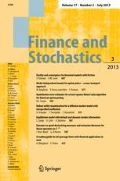Abstract
We consider the exponential utility maximization problem under partial information. The underlying asset price process follows a continuous semimartingale and strategies have to be constructed when only part of the information in the market is available. We show that this problem is equivalent to a new exponential optimization problem which is formulated in terms of observable processes. We prove that the value process of the reduced problem is the unique solution of a backward stochastic differential equation (BSDE) which characterizes the optimal strategy. We examine two particular cases of diffusion market models for which an explicit solution has been provided. Finally, we study the issue of sufficiency of partial information.
Similar content being viewed by others
References
Davis, M.H.A.: Optimal hedging with basis risk. In: Kabanov, Y., Liptser, R., Stoyanov, J. (eds.) From Stochastic Calculus to Mathematical Finance, pp. 169–187. Springer, Berlin (2006)
Delbaen, F., Grandits, P., Rheinländer, T., Samperi, D., Schweizer, M., Stricker, C.: Exponential hedging and entropic penalties. Math. Finance 12, 99–123 (2002)
Dellacherie, C., Meyer, P.A.: Probabilités et Potentiel, II. Hermann, Paris (1980)
Di Masi, G.B., Platen, E., Runggaldier, W.J.: Hedging of options under discrete observation on assets with stochastic volatility. In: Bolthausen, E., Dozzi, M., Russo, F. (eds.) Seminar on Stoch. Anal. Rand. Fields Appl., pp. 359–364. Birkhäuser, Basel (1995)
Friedman, A.: Stochastic Differential Equations and Applications, vol. 1. Academic Press, New York (1975)
Frei, C., Schweizer, M.: Exponential utility indifference valuation in two Brownian settings with stochastic correlation. Adv. Appl. Probab. 40, 401–423 (2008)
Henderson, V.: Valuation of claims on nontraded assets using utility maximization. Math. Finance 12, 351–373 (2002)
Henderson, V., Hobson, D.G.: Real options with constant relative risk aversion. J. Econ. Dyn. Control 27, 329–355 (2002)
Hobson, D.G.: Stochastic volatility models, correlation, and the q-optimal measure. Math. Finance 14, 537–556 (2004)
Hu, Y., Imkeller, P., Müller, M.: Utility maximization in incomplete markets. Ann. Appl. Probab. 15, 1691–1712 (2005)
Jacod, J.: Calcul Stochastique et Problèmes de Martingales. Lecture Notes in Math., vol. 714. Springer, Berlin (1979)
Karatzas, I., Zhao, X.: Bayesian adaptive portfolio optimization. In: Jouini, E., Cvitanić, J., Musiela, M. (eds.) Option Pricing, Interest Rates and Risk Management. Handb. Math. Finance, pp. 632–669. Cambridge University Press, Cambridge (2001)
Kazamaki, N.: Continuous Exponential Martingales and BMO. Lecture Notes in Math., vol. 1579. Springer, Berlin (1994)
Kohlmann, M., Xiong, D., Ye, Z.: Change of filtrations and mean-variance hedging. Stochastics 79, 539–562 (2007)
Lakner, P.: Optimal trading strategy for an investor: the case of partial information. Stochastic Process. Appl. 76, 77–97 (1998)
Liptser, R.S., Shiryayev, A.N.: Martingale Theory. Nauka, Moscow (1986)
Liptser, R.S., Shiryayev, A.N.: Statistics of Random Processes. I. General Theory. Springer, New York (1977)
Mania, M., Tevzadze, R.: A unified characterization of q-optimal and minimal entropy martingale measures by semimartingale backward equations. Georgian Math. J. 10, 289–310 (2003)
Mania, M., Tevzadze, R., Toronjadze, T.: Mean–variance hedging under partial information. SIAM J. Control Optim. 47, 2381–2409 (2008)
Merton, R.C.: Lifetime portfolio selection under uncertainty: the continuous-time case. Rev. Econ. Stat. 51, 247–257 (1969)
Monoyios, M.: Performance of utility-based strategies for hedging basis risk. Quant. Finance 4, 245–255 (2004)
Morlais, M.A.: Quadratic BSDEs driven by a continuous martingale and applications to the utility maximization problem. Finance Stoch. 13, 121–150 (2009)
Musiela, M., Zariphopoulou, T.: An example of indifference prices under exponential preferences. Finance Stoch. 8, 229–239 (2004)
Oleinik, O.A., Radkevich, E.V.: Second Order Equations with Nonnegative Characteristic Form. Plenum, New York (1973)
Pham, H.: Mean–variance hedging for partially observed drift processes. Int. J. Theor. Appl. Finance 4, 263–284 (2001)
Pham, H., Quenez, M.C.: Optimal portfolio in partially observed stochastic volatility models. Ann. Appl. Probab. 11, 210–238 (2001)
Rouge, R., El Karoui, N.: Pricing via utility maximization and entropy. Math. Finance 10, 259–276 (2000)
Schweizer, M.: Risk-minimizing hedging strategies under restricted information. Math. Finance 4, 327–342 (1994)
Shiryayev, A.N.: Optimal Stopping Rules. Springer, New York (1978)
Sekine, J.: On exponential hedging and related quadratic backward stochastic differential equations. Appl. Math. Optim. 54, 131–158 (2006)
Tevzadze, R.: Solvability of backward stochastic differential equations with quadratic growth. Stoch. Process. Appl. 118, 503–515 (2008)
Zohar, G.: A generalized Cameron–Martin formula with applications to partially observed dynamic portfolio optimization. Math. Finance 11, 475–494 (2001)
Author information
Authors and Affiliations
Corresponding author
Additional information
Partially supported by the MiUR Project “Stochastic Methods in Finance”. M. Mania gratefully acknowledges financial support from ICER, Torino.
The authors would like to thank a Co-Editor and two referees for their valuable comments and suggestions. Special thanks are also due to Revaz Tevzadze for several helpful discussions.
Rights and permissions
About this article
Cite this article
Mania, M., Santacroce, M. Exponential utility maximization under partial information. Finance Stoch 14, 419–448 (2010). https://doi.org/10.1007/s00780-009-0114-z
Received:
Accepted:
Published:
Issue Date:
DOI: https://doi.org/10.1007/s00780-009-0114-z
- Backward stochastic differential equation
- Semimartingale market model
- Exponential utility maximization problem
- Partial information, sufficient filtration



